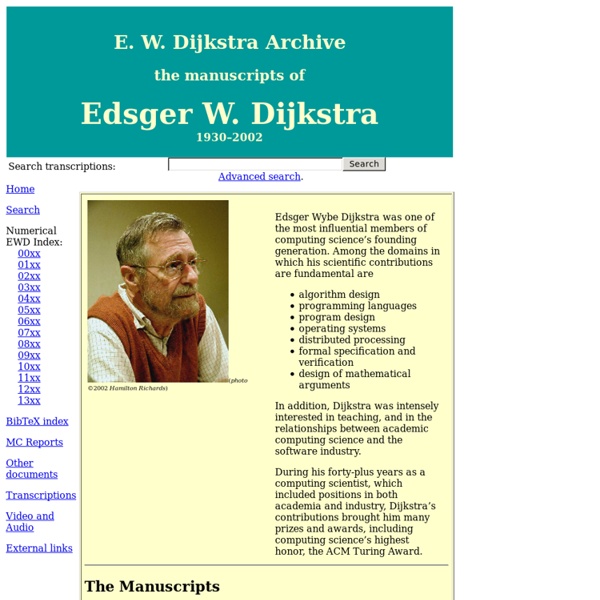Dijkstra Archive: Home page - StumbleUpon

code {poems} by Ishac Bertran (@ishacbertran) - Poetry with code - Submissions now open!
Ishac Bertran sent us details about his latest project - Code and Poetry: Lately I’ve been sketching an experimental project about Code and Poetry. This two terms have been connected for many reasons – I thought it would be interesting to explore the most literal meaning of it, using code to write traditional poetry. Code has many layers of abstraction that normal language doesn’t have, and I hope this can provide a new angle to contemporary poetry. Poetry written with code meant to be read in a book, not run in a computer. Ishac will be collecting code poems from people interested in contributing. You can find more information about the project on the website: {poems} is a project by Ishac Bertran
C Craft - Chapter&1.&Introduction
C is the desert island language. This is my favourite statement from a talk Rob Pike gave in 2001. Despite its age, despite many flaws, C is still the de facto standard, the lingua franca. Or as Linus Torvalds puts it, “C is the only sane choice”. One of C’s designers, Dennis Ritchie, gives a modest account of the evolution of C. The canonical reference, Kernighan and Ritchie’s "The C Programming Language" is slim, yet contains much more than the language specification. Not only is C easy for humans to understand, but machines too can pick up the language quickly. I can roughly envision the assembly generated by a C statement, so I can make educated guesses about time and space efficiency. Brevity is the soul of wit. In my Eiffel days, I was encouraged to write "integer", not "int", "character", not "char", and so on. We call friends by shortened versions of their names. C possesses elementary yet powerful constructs that are missing from other languages.
s Introduction to Complex Systems - StumbleUpon
by David Kirshbaum I. Introduction: Complex Systems Theory : Basic Definition II. III. I. A Complex System is any system which involves a number of elements, arranged in structure(s) which can exist on many scales. Previously, when studying a subject, researchers tended to use a reductionist approach which attempted to summarize the dynamics, processes, and change that occurred in terms of lowest common denominators and the simplest, yet most widely provable and applicable elegant explanations. But since the advent of powerful computers which can handle huge amounts of data, researchers can now study the complexity of factors involved in a subject and see what insights that complexity yields without simplification or reduction. Scientists are finding that complexity itself is often characterized by a number of important characteristics: (II.1) Self-Organization(II.2) Non-Linearity(II.3) Order/Chaos Dynamic(II.4) Emergent Properties. (II.1) Self-Organization Examples (II.2) Non-Linearity
Related:
Related:



